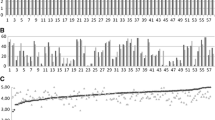Abstract
BACKGROUND: Learner feedback is the primary method for evaluating clinical faculty, despite few existing standards for measuring learner assessments.
OBJECTIVE: To review the published literature on instruments for evaluating clinical teachers and to summarize themes that will aid in developing universally appealing tools.
DESIGN: Searching 5 electronic databases revealed over 330 articles. Excluded were reviews, editorials, and qualitative studies. Twenty-one articles describing instruments designed for evaluating clinical faculty by learners were found. Three investigators studied these papers and tabulated characteristics of the learning environments and validation methods. Salient themes among the evaluation studies were determined.
MAIN RESULTS: Many studies combined evaluations from both outpatient and inpatient settings and some authors combined evaluations from different learner levels. Wide ranges in numbers of teachers, evaluators, evaluations, and scale items were observed. The most frequently encountered statistical methods were factor analysis and determining internal consistency reliability with Cronbach’s α. Less common methods were the use of test-retest reliability, interrater reliability, and convergent validity between validated instruments. Fourteen domains of teaching were identified and the most frequently studied domains were interpersonal and clinical-teaching skills.
CONCLUSIONS: Characteristics of teacher evaluations vary between educational settings and between different learner levels, indicating that future studies should utilize more narrowly defined study populations. A variety of validation methods including temporal stability, interrater reliability, and convergent validity should be considered. Finally, existing data support the validation of instruments comprised solely of interpersonal and clinical-teaching domains.
Similar content being viewed by others
References
Jones RG, Froom JD. Faculty and administration view of problems in faculty evaluations. Acad Med. 1994;69:476–83.
Beckman TJ, Lee MC, Mandrekar JN. A comparison of clinical teaching evaluations by resident and peer physicians. Med Teach. 2004;26:321–5.
Downing SM. Validity: on the meaningful interpretation of assessment data. Med Educ. 2003;37:830–7.
Crossley J, Humphris G, Jolly B. Assessing health professionals. Med Educ. 2002;36:800–4.
Beckman TJ, Lee MC, Rohren CH, Pankratz VS. Evaluating an instrument for the peer review of inpatient teaching. Med Teach. 2003;25:131–5.
Benbassat J, Bachar E. Validity of students’ ratings of clinical instructors. Med Educ. 1981;15:373–6.
Cohen R, McRae H, Jamieson C. Teaching effectiveness of surgeons. Am J Surg. 1996;171:612–4.
Copeland HL, Hewson MG. Developing and testing an instrument to measure the effectiveness of clinical teaching in an academic medical center. Acad Med. 2000;75:161–6.
Donnelly MB, Woolliscroft JO. Evaluation of instructors by third year medical students. Acad Med. 1989;64:159–64.
Donner-Banzhoff N, Merle H, Baum E, Basler HD. Feedback for general practice trainers: developing and testing a standardized instrument using the importance-quality-score method. Med Educ. 2003;37:772–7.
Guyatt GH, Nishikawa J, Willan A, et al. A measurement process for evaluating clinical teachers in internal medicine. Can Med Assoc J. 1993;149:1097–102.
Hayward RA, Williams BC, Gruppen LD, Rosenbaum D. Measuring attending physician performance in a general medicine outpatient clinic. J Gen Intern Med. 1995;10:504–10.
Irby DM, Rakestraw P. Evaluating clinical teaching in medicine. J Med Educ. 1981;56:181–6.
James PA, Osborne JW. A measure of medical instructional quality in ambulatory settings: the MedIQ. Fam Med. 1999;31:263–9.
Litzelman DK, Westmorland GR, Skeff KM, Stratos GA. Student and resident evaluations of faculty—how reliable are they? Acad Med. 1999;74(suppl Oct):s25-s27.
Litzelman DK, Stratos GA, Marriott DJ, Skeff KM. Factorial validation of a widely disseminated educational framework for evaluating clinical teachers. Acad Med. 1998;73:688–95.
Mcgill MK, McClure C, Commerford K. A system for evaluating teaching in the ambulatory setting. Fam Med. 1986;18:173–4.
McLeod PJ, James CA, Abrahamowicz M. Clinical tutor evaluation: a 5-year study by students on an in-patient service and residents in an ambulatory care clinic. Med Educ. 1993;27:48–54.
Ramsbottom-Lucier MT, Gillmore GM, Irby DM, Ramsey PG. Evaluation of clinical teaching by general internal medicine faculty in outpatient and inpatient settings. Acad Med. 1994;69:152–4.
Risucci DA, Lutsky L, Rosati RJ, Tortolani AJ. Reliability and accuracy of resident evaluations of surgical faculty. Eval Health Prof. 1992;15:313–24.
Shellenberger S, Mahan JM. A factor analytic study of teaching in off-campus general practice clerkships. Med Educ. 1982;16:151–5.
Solomon DJ, Speer AJ, Rosebraugh CJ, DiPette DJ. The reliability of medical student ratings of clinical teaching. Eval Health Prof. 1997;20:343–52.
Steiner IP, Franc-Law J, Kelly KD, Rowe BH. Faculty evaluation by residents in an emergency medicine program: a new evaluation instrument. Acad Emerg Med. 2000;7:1015–21.
Tortolani AJ, Rissucci DA, Rosati RJ. Resident evaluation of surgical faculty. J Surg Res. 1991;51:186–91.
Williams BC, Litzelman DK, Babbott SF, Lubitz RM, Hofer TP. Validation of a global measure of faculty’s clinical teaching performance. Acad Med. 2002;77:177–80.
Snell L, Tallett S, Haist S, et al. A review of the evaluation of clinical teaching: new perspectives and challenges. Med Educ. 2000;34:862–70.
Williams RG, Klamen DA, McGaghie WC. Cognitive, social and environmental sources of bias in clinical performance ratings. Teach Learn Med. 2003;15:270–92.
American Educational Research Association, American Psychological Association, National Council on Measurement in Education. Standards for Educational and Psychological Testing. Washington, DC: American Educational Research Association; 1999.
Nunnally JC, Berstein IH. Psychometric Theory. 3rd ed. New York: McGraw-Hill. 1994:211–54.
DeVillis RF. Scale Development: Theory and Applications. London: Sage Publications. 1991;94:102–37.
Durning SJ, Cation LJ, Jackson JL. The reliability and validity of the American Board of Internal Medicine Monthly Evaluation Form. Acad Med. 2003;78:1175–82.
Schwab DP. Construct validity in organizational behavior. Res Organ Behav. 1980;2:3–43.
Perkoff GT. Teaching clinical medicine in the ambulatory setting: an idea whose time may have finally come. N Engl J Med. 1986;314:27–31.
Downing DM, Haladyna TM. Validity threats: overcoming interference with proposed interpretations of assessment data. Med Educ. 2004;38:327–33.
Irby DM. Evaluating instruction in medical education. J Med Educ. 1983;58:844–9.
Downing SM. Reliability: on the reproducibility of assessment data. Med Educ. In Press.
Howell DC. Statistical Methods for Psychology. 5th ed. Pacific Grove, Calif: Duxbury; 2002.
McMillan JH, Schumacher S. Research in Education: A Conceptual Introduction. 5th ed. New York: Addison Wesley Longman; 2001.
Author information
Authors and Affiliations
Corresponding author
Rights and permissions
About this article
Cite this article
Beckman, T.J., Ghosh, A.K., Cook, D.A. et al. How reliable are assessments of clinical teaching?. J GEN INTERN MED 19, 971–977 (2004). https://doi.org/10.1111/j.1525-1497.2004.40066.x
Issue Date:
DOI: https://doi.org/10.1111/j.1525-1497.2004.40066.x



